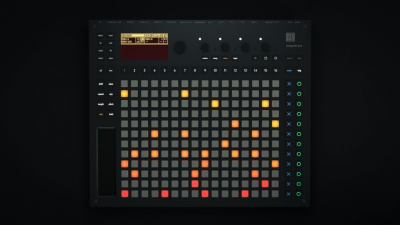maxmatteo
||
Das Teil sieht mal interessant aus. Bin sehr gespannt:
 dadamachines.com
dadamachines.com

composer pro
composer pro is a standalone performance MIDI sequencer with support for open source audio engines. Meet composer pro Composer is a Performance Sequencer that can be the ControlCenter of a Live Music Setup or can be included as a Performance Controller Instrument in existing Electronic Music...

Code:
composer pro specifications
Sequencer
• 16 × MIDI/Audio tracks (Machines)
• up to 12 Patterns per Machine
• Up to 16 Bars per pattern
• Individual track lengths
• Individual clock multiplier/divider per track
• Custom Chord Pads, Custom Trigger Views
• Parameter per Step
• Unquantized/Quantized Recording
• Step-Repeat and Phrase-Repeat
• Real-Time Note correction (Autoscale)
• Record Automation
• Full real-time control
Processing
• 2 x 120Mhz ARM Cortex M4F Microcontrollers with FPU
• 1 x FPGA – Lattice ICE40UP5K
• Compute module 3+ SoC. quad core 1.2ghz, 1gb RAM, 8-32gb eMMC.
Storage
• Micro SD-Card storage
• unlimited amount of Projects*
• 8-32 on Board RAM
Hardware
• 261 backlit RGB Buttons
• 1 x Menu encoder with switch & 4 x Parameter encoders
• 2-dimensional Touchstrip (for Manipulation)
• 128 × 64 pixel OLED screen, 16-level bright white huge pixels.
• Footswitch input to control start, stop, and record
• USB MIDI Host
• USB-C MIDI Device – USB 2.0
• 2 x DIN MIDI In
• 2 x DIN MIDI Out
• 1 x Sync In / 1 x Sync Out
• 1 x 1/4” stereo headphone jack with gain
• 2 x 1/4” impedance balanced audio out jacks
• 2 x 1/4” impedance balanced audio in jacks
• HDMI Out
• 4 x USB Host ports for devices
• Power inlet: Center positive 5.5 × 2.5 mm barrel jack, 12 V DC, 5 A
Physical specifications
• Frontpanel – anodized black aluminium
• Bottom Shell – powder coated black aluminium
• Dimensions: W 330 × D 280 × H 40 mm (13.3” × 7.2” × 2.5”) (including knobs, jacks, and rubber feet)
• Weight: approximately 2.5 kg (5 lbs)




